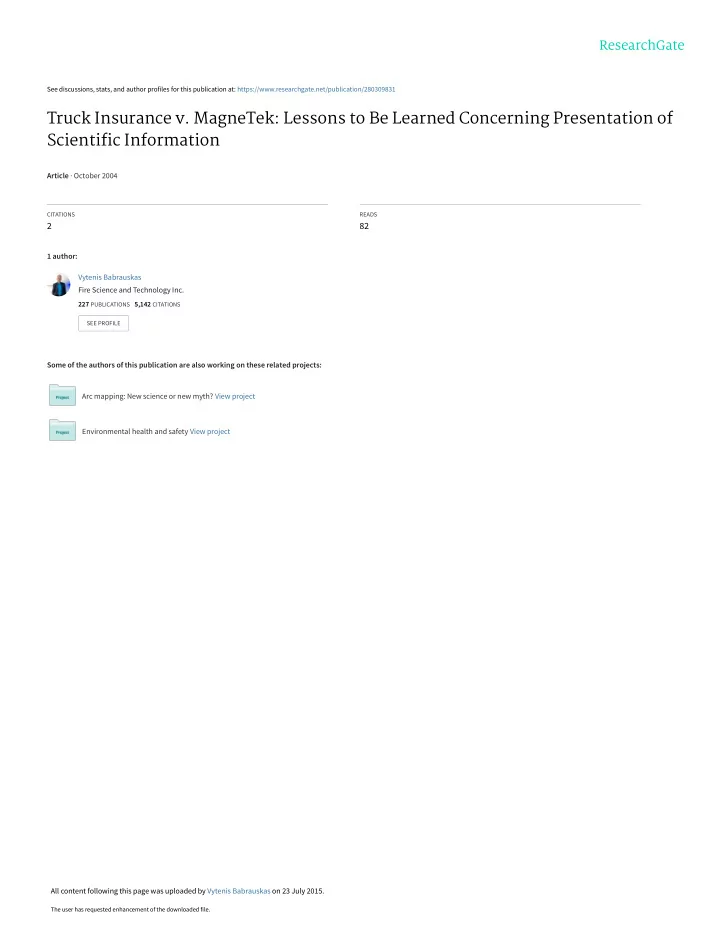

See discussions, stats, and author profiles for this publication at: https://www.researchgate.net/publication/280309831 Truck Insurance v. MagneTek: Lessons to Be Learned Concerning Presentation of Scientific Information Article · October 2004 CITATIONS READS 2 82 1 author: Vytenis Babrauskas Fire Science and Technology Inc. 227 PUBLICATIONS 5,142 CITATIONS SEE PROFILE Some of the authors of this publication are also working on these related projects: Arc mapping: New science or new myth? View project Environmental health and safety View project All content following this page was uploaded by Vytenis Babrauskas on 23 July 2015. The user has requested enhancement of the downloaded file.
Citation: Babrauskas, V., Truck Insurance v. MagneTek: Lessons to Be Learned Concerning Presentation of Scientific Information, Fire & Arson Investigator 55 :2, 9-10 (Oct. 2004). Truck Insurance v. MagneTek : Lessons to Be Learned Concerning Presentation of Scientific Information by Vytenis Babrauskas, Ph.D. Recently, a U.S. Court of Appeals decision was made in Colorado 1 which is very unfortunate and which may make it more difficult for fire investigators to deal with ignition of fires which have been caused by long-term, low- temperature heating of wood. I have not had personal involvement with this case and know of the facts only as presented in the Court decision. Thus, my objective here is not to discuss whether justice was served for the parties involved, but, rather, to point out some implications for fire investigators and to offer some ways of coping with the new legal impediments that have been created. The case concerned a ceiling which may have been set on fire by a fluorescent light ballast. The Court did not understand the difference between short-term heating of wood, where the concept of a roughly-known ignition temperature is applicable, and long-term, low-temperature heating behavior. When cellulosic substances which are capable of smoldering are exposed to sustained heating at temperatures which are much lower than the ‘ignition temperature’ applicable to short-term heating, under some conditions they may still ignite. This phenomenon is not newly-discovered or scientifically disputed. A scientific treatise 2 was already published in 1984, although it is so highly mathematical that it would not be comprehensible to most investigators. Instead, the Court took as fact that wood has an ignition temperature of “approximately 400ºF” [204ºC] and rejected the plaintiffs’ case out of hand, because they could only demonstrate that, under normal conditions, the ballast would reach 232ºF [111ºC] and, under failure conditions, 340ºF [171ºC]. But the fact that smolderable combustibles may become ignited at temperatures much lower than an ignition temperature obtained during short-term heating has been known for over 100 years, as demonstrated by 19 th century studies on spontaneous-combustion fires onboard ships carrying coal 3 . The Court specifically rejected the plaintiffs’ claims because it concluded that the plaintiffs were presenting what it called a “pyrolysis theory.” It then went on to state that it found “the long-term, low-temperature ignition theory” to be “unreliable” and, therefore, excludable under Daubert . The implication to fire investigators now is that any time they encounter a case involving the long-term, low-temperature ignition of wood, their presentation might be thrown out of court. To avoid this, it is important to realize how the scientific presentation was made in the MagneTek case (or at least how it was interpreted by the court), and to make presentations in future cases which avoid such an out- of-hand rejection by the court. “Pyrolysis” is not a theory, it is a definition . As such, it cannot be right or wrong (but, as with any definition, can be adhered to widely, or not). Analytical chemists define 4 “pyrolysis” as “Transformation of a compound into one or more other substances by heat alone, i.e., without oxidation”. If oxygen does play a role, then chemists refer to the process as “oxidative pyrolysis,” and the latter term is widely used in the thermal-analysis branch of chemistry. In fire science, we normally define “pyrolysis” as stated in my Ignition Handbook 5 : “The chemical degradation of a substance by the action of heat.” Thus, the slight difference is that, in fire science, we include both oxidative and non-oxidative pyrolysis in the general definition. But “pyrolysis” does not explain anything concerning long-term, low-temperature ignitions of wood. It is an observable fact that wood is a material which will pyrolyze, as opposed to, say, gold, which can be raised to quite high temperatures without suffering chemical degradation. That fact, by itself, says nothing as to whether it can even ignite, much less under what conditions it will ignite. To determine under what conditions something can ignite, in principle, we can do one of two things: (1) use a scientific theory to make a calculation; or (2) consult observational data collected on the topic. 1 Truck Insurance Exchange v. MagneTek, Inc. (No. 03-1026), U.S. Court of Appeals, Tenth Circuit, Appeal from the U.S. District Court for the District of Colorado, D.C. No. 00-RB-2218(CBS), Filed Feb. 25, 2004. 2 Bowes, P. C., Self-Heating: Evaluating and Controlling the Hazards , Her Majesty’s Stationery Office, London (1984). 3 Rowan, T., Coal Spontaneous Combustion and Explosions—Occurring in Coal Cargoes—Their Treatment and Prevention , E&FN Spon, London & New York (1882). 4 Lewis, R J. sr., Hawley’s Condensed Chemical Dictionary, 14 th ed., p. 941, Wiley, New York (2001). 5 Babrauskas, V., Ignition Handbook , Fire Science Publishers/Society of Fire Protection Engineers, Issaquah WA (2003).
Recommend
More recommend